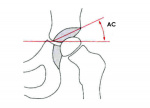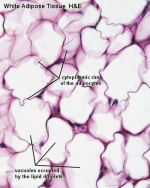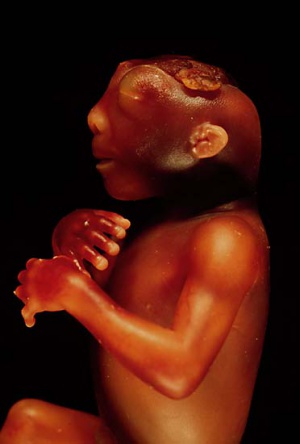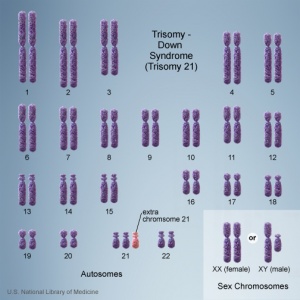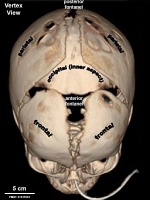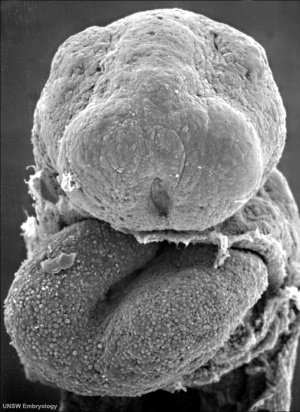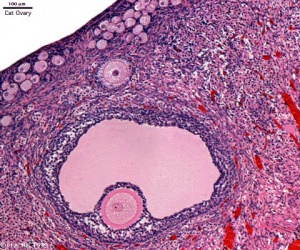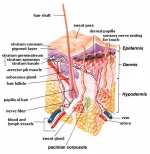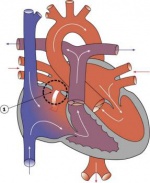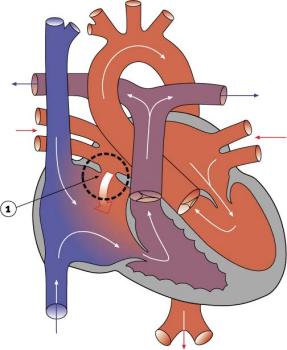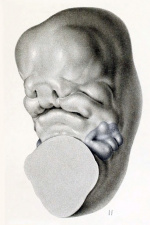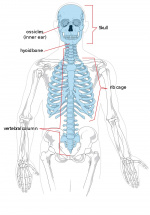A
| Embryology - 27 Apr 2024 |
|---|
| Google Translate - select your language from the list shown below (this will open a new external page) |
|
العربية | català | 中文 | 中國傳統的 | français | Deutsche | עִברִית | हिंदी | bahasa Indonesia | italiano | 日本語 | 한국어 | မြန်မာ | Pilipino | Polskie | português | ਪੰਜਾਬੀ ਦੇ | Română | русский | Español | Swahili | Svensk | ไทย | Türkçe | اردو | ייִדיש | Tiếng Việt These external translations are automated and may not be accurate. (More? About Translations) |
Glossary Links
- Glossary: A | B | C | D | E | F | G | H | I | J | K | L | M | N | O | P | Q | R | S | T | U | V | W | X | Y | Z | Numbers | Symbols | Term Link
A
AABR
- An acronym for Automated Auditory Brainstem Response the neural pathway to test hearing and other brainstem pathways.
- (More? Hearing test | Hearing | Lecture - Sensory Development | Search Pubmed)
A-band
- (anisotropic-band) Acronym for anisotropic band a skeletal muscle sarcomere term based upon properties under a polarizing microscope. An A-band contains the entire length of a single thick (myosin) filament.
- (More? skeletal muscle)
abdomen
abnormal growth
- Prenatally measured by ultrasound and comparing known anatomical size parameters (abdominal circumference (AC), Biparietal Diameter (BPD), Head Circumference (HC), and Femur Length (FL) with gestational age curves for these structures. Postnatally measured as a weight, length (height), or head circumference below the −2 or above the +2 standard deviation score (SDS) lines.
- (More? ultrasound | DOHAD | Fetal Origins Hypothesis | Postnatal - Growth Charts)
abdominal circumference
- (AC) An ultrasound measurement of Abdominal Circumference (AC) is used to determine fetal age and normal development (small/large/abnormal) parameters. Measured at the outer edge of the circumference of the body plane in which the portal vein or stomach can be visualized in a tangential section. It is one of the four typical ultrasound assessments of fetal size and age: Biparietal Diameter (BPD), Head Circumference (HC), Abdominal Circumference (AC), and Femur Length (FL). Abdominal Circumference of less than 31 cm at 36 to 40 weeks gestation is a predictor of intrauterine growth retardation (IUGR).
- (More? ultrasound | Musculoskeletal System | fetal | birth)
abnormal spindle-like microcephaly-associated protein
- A protein concentrated at mitotic spindle poles in embryonic neuroepithelial cells (progenitor cells of the brain) and down-regulated when they switch from proliferative to neurogenic divisions. Protein is associated with determining human cerebral cortical size, possibly by maintaining symmetric cleavage plane orientation in neuroepithelial cells during brain development.
- (More? neural | OMIM ASPM | PMID 16798874 | Search Pubmed))
abortion
- The premature expulsion or loss of embryo, may be induced (medical) or spontaneous (miscarriage).
abruptio placenta
- (placental abruption) Clinical term for when the placenta separates from the maternal uterus (decidua). Abnormal placentation and other environmental causes can lead to this condition. Depending upon degree of separation and subsequent bleeding, there can be a range of outcomes, the most serious are both fetal and/or maternal death.
- (More? placenta abnormalities | Medline Plus | Search Pubmed)
absolute risk
- Term used in describing the effect of environmental teratogens on development. This epidemiological statistical term describes the high likely rate of occurrence of an abnormal phenotype among individuals exposed to the agent (e.g. fetal alcohol syndrome). The other risk descriptor term used to describe the likelyhood of an abnormality is relative risk.
AC
- Acronym for Abdominal Circumference.
ACAMS
- Acronym for Australian Congenital Anomalies Monitoring System that monitors Australian data for birth anomalies detected up to 1 year of age. ACAMS superseded the National Congenital Malformations and Birth Defects Data Collection (NCMBD), which commenced in 1981. The equivalent European system is called (eurocat|) and the USA system is (NVSS).
- (More? Australian Birth Anomalies System | Australian Statistics]] | Human Abnormal Development | [https://npesu.unsw.edu.au/data-collection/australian-congenital-anomalies-monitoring-system-acams National Perinatal Epidemiology and Statistics Unit)
acardiac twins
- (acardia, twin reversed-arterial perfusion (TRAP) sequence, chorioangiopagus parasiticus) An extreme form of Twin-twin transfusion syndrome. In a twinned human fetal development where monozygotic twinning or higher multiple births have an artery-to-artery and a vein-to-vein anastomosis in the monochorial placenta. The incidence is of 1% of monochorionic twin pregnancies (1 of 35,000 pregnancies).
- (More? twinning | Search Pubmed)
acaricide
- Acarida are a subclass of the athropods, ticks and mites. Chemicals used for killing or preventing ticks and mites in crops or animals. Some of the early chemicals (eg endosulphan) may have also had a suggested endocrine disruptor function.
accessory pancreatic duct
- (APD, Santorini's duct) A pancreas duct for exocrine secretion into the gastrointestinal tract. This duct may be present as an anatomical variation due to the embryological origin of the pancreas from two pancreatic buds (dorsal and ventral). Note the main pancreatic duct (MPD) from the dorsal bud, present in the body and tail of the pancreas (also called Wirsung's duct).
ACE3
- Acronym for angiotensin converting enzyme (ACE) homologue ACE3, a protein isolated by binding to IZUMO1-interacting protein 1, a spermatozoa acrosome protein. It is also a homologue of the testis-specific ACE (tACE).
- (More? spermatozoa)
acephaly
- A rare developmental abnormality resulting in the absence of head. This is an embryonic lethal abnormality.
acetabular index
- (acetabular angle) A clinical measurement used to classify hip development and displasia. The index is based upon radiograph analysis of the acetabular inclination before ossification of the triradiate cartilage and defined as the angle between Hilgenreiner's line and a line from the inferior margin of the iliac bone through the acetabular bony rim.
- (More? Image - Acetabular angle | Limb Abnormalities)
acheiria
- A limb abnormality with a missing hand or foot as described in the original classical classification of limb deficiencies.
- (More? Lecture - Limb Development | Limb Abnormalities)
achondroplasia
- Musculoskeletal defect of short limb skeletal dysplasia, due to a mutation in a dominant gene encoding fibroblast growth factor receptor-3 (FGFR3). Most common limb dysplasia, with shortened long bones (mainly proximal long bones) and is difficult to prenatally diagnose. Other mutaions of this gene cause milder skeletal dysplasia (hypochondroplasia) and a lethal skeletal dysplasia (thanatophoric dysplasia).
- (More? bone | musculoskeletal abnormalities | OMIM Achondroplasia | OMIM FGFR3)
Acquired Immune Deficiency Syndrome (AIDS)
- A fatal disease caused by a virus (human immunodeficiency virus, HIV) that destroys the immune system's ability to fight off infection. HIV virus is capable of being transmitted from mother to fetus.
acrocentric
- Term used to describe chromosomes which pair with a centromere located very close to one end giving a "V" shape rather than "X" of a central centromere pair. In the human, chromosomes 13,14,15,21 and 22 are acrocentric. In bovine all chromosomes are acrocentric.
- (More? Bovine Development)
acrolein
- A reactive aldehyde (conjugated Type-2 alkenes) formed as a product of lipid peroxidation in biological systems. Recently identified as a cigarette-related lung cancer agent
- (More? smoking | PNAS Article)
acridine dye
- A mutagenic chemical compound that causes a frameshift mutation in DNA by intercalating between adjacent base pairs of the double helix.
- (More? Molecular Development)
acrodynia
- (Greek, acrodynia = painful extremities) chronic mercury poisoning in infants and young, also called "Pink Disease" occurred throughout the world (Australia 1890's) before the recognition of mercury's toxic effects. Mercurous chloride was used in "teething powders" which were given to crying babies as a purgative agent to cleanse the system.
- (More? Abnormal Development - Heavy Metals | Michigan Health MercurySpillFactsheet_85689_7.pdf)
acromegaly
- (Greek, acro = "extremities"; megaly = "enlargement") Clinical term for a hormonal disorder that results from excess growth hormone (GH) in the body. The pituitary produces excessive amounts of growth hormone, usually due to benign, or noncancerous, pituitary tumours (adenomas). Childhood adenomas lead to gigantism rather than acromegaly, due to continued and excess growth in the long bones in the legs.
- (More? pituitary | Bone | NIH - acromegaly)
acroplaxome
- The spermatozoa structure which forms the acrosome plate with intermediate filament bundles of the marginal ring at the leading edge of the acrosome.
- (More? Spermatozoa Development | Fertilization)
acrosin
- A spermatozoa acrosomal protein has a role in fertilization including that of lysis of the zona pellucida (a serine protease) and in secondary zona pellucida (ZP) binding. Stored in mature spermatazoa as proacrosin.
- (More? spermatozoa | fertilization | OMIM - acrosin)
acrosome
- The spermatozoa cap-shaped cellular structure formed from the golgi apparatus and contains a packet of enzymes located that allows it to dissolve a hole in the specialized extracellular matrix (zona pellucida, egg coat) surrounding the oocyte (egg). This enzymic digestion then allows the spermatazoa to penetrate and fertilize the egg.
- Golgi apparatus - proacrosomal granule - acrosomal compaction - acrosome
- (More? spermatozoa | zona pellucida | fertilization)
acrosome compaction
- A process in spermatogenesis that occurs in the final stages of spermatid to spermatozoa. The process is part of the spermatozoa head compaction, from a round nucleus, and requires protamines and zona pellucida binding protein 1 (ZPBP1).
- (More? spermatozoa | Fertilization | PMID 17664285)
acrosome reaction
- The chemical change within the spermatozoa following binding to the zona pellucida, only acrosome reacted spermatozoa have an ability to fuse with oocytes. Initially the spermatozoa sheds the plasma membrane in the acrosomal cap area and newly expose the inner-acrosomal membrane. Followed by the release of acrosomal enzymatic contents that degrade the zona pellucida and allow a spermatozoa to penetrate an oocyte. The spermatozoa protein Izumo sperm-egg fusion protein 1 (IZUMO1) has been identified as key for the process of spermatozoa-oocyte fusion. Requires the influx of Ca2+ into the spermatozoa through voltage-dependent Ca2+ channels and store-operated channels.
- (More? spermatozoa | zona pellucida | fertilization)
activin A
- (inhibin, erythroid differentiation factor) A transforming growth factor beta (TGFbeta) superfamily member which has roles in many different tissues. Acts through binding a number of activin receptors, transmembrane ser/thr kinase receptors. This protein is involved in the process of uterine endometrium development (decidualization) of human endometrial stromal cells following blastocyst implantation.
- (More? Week 2 | OMIM - inhibin)
adactyly
- The absence of bones metacarpal or metatarsal leading to an absence of all digits as described in the original classical classification of limb deficiencies.
- (More? limb abnormalities)
ADAM
- (Adam, fertilin, fertilin-beta) Protein acronym for A Disintegrin And Metalloprotease, a family of integrin ligands with the adhesive activity largely mediated by the disintegrin-like domain (named by homology to disintegrin domains in snake venom metalloproteases). Mouse spermatozoa express (Adam1a, Adam2, Adam3) with Adam3 required for zona pellucida binding and Adam2 binds to α4/α9 (ITGA4/ITGA9) integrins on the oocyte.
- (More? spermatozoa | zona pellucida | fertilization | Mouse Development | PMID 10652535 | PMID 21060781 | OMIM - Adam2)
ADAMTS-13
- A blood metalloprotease found in plasma which cleaves von Willebrand factor (VWF) in the A2 domain at the Tyr-1605 -1606 bond.
adenine
- (adenine triphosphate) One of the 4 types (ATCG) of nucleotides that make up DNA. Base pairs with thymidine by 2 hydrogen bonds.
adenohypophyseal placode
- Specialised cranial surface midline ectoderm placode region that will form the endocrine anterior pituitary (adenohypophysis).. The transient embryonic structure, Rathke’s pouch, is formed by folding in of this region on the roof of the oral cavity.
- (More? pituitary)
adenohypophysis
- (anterior pituitary, pars distalis) The anterior part of the pituitary, which develops in the early embryo from the surface ectoderm adenohypophyseal placode. This placode will fold inward on the roof of the pharynx forming a transient structure Rathke's pouch, that looses its connection with the surface.
- (More? pituitary)
adenomatous rest
- A kidney benign tumor developing from embryonic blastema cells. Blastema cells persist and under either genetic or epigenetic can change to become a neoplastic rest. These neoplastic rests can develop postnatally as a benign form (adenomatous rest) or a malignant Wilm's tumour form. The rests are further characterised by the time of generation leading to different anatomical kidney locations: early intralobar nephrogenic rests (within the renal lobe) and late pelilobar nephrogenic rests (periphery of the renal lobe).
adenomyosis
- (endometriosis interna, adenomyoma) A uterus disease involving infiltration (immediately adjacent to the endometrial cavity) of endometrial glands and stroma within the myometrium. Difficult to distinguish from leiomyoma.
adenovirus
- A Class I virus containing a single double-stranded DNA (dsDNA), which can cause infections in the upper respiratory tract and gastrointestinal tract in many animals.
adipocyte
- The mature fat cell found in adipose (fat) tissue that surrounds tissues and forms the majority of the inner hypodermis layer of the skin. The embryonic origin is mesoderm forming connective tissue. In the newborn, a special brown adipocyte form brown adipose "brown fat" that can be rapidly metabolised for energy and heat. In the adult, these cells "cushion" tissues, have a storage function and also been identified as having an endocrine function secreting several hormones including adiponectin, leptin, and resistin.
adipogenesis
- The term used to describe the process of differentiation of preadipocytes into adipocytes.
adipose
- Fat, mesodermal in origin it is a type of connective tissue consisting mainly of adipocytes. The two forms of adipose are white and brown adipose tissue. Brown adipose is found in newborns (2 - 5 % of the body weight) and can be used to dissipate stored energy as heat (thermogenesis), while adults have mainly white adipose. Adipose tissue also has an endocrine function secreting the hormones leptin, adiponectin, and resistin.
adjuvant
- Immunology term describing a preparation which may be added to a vaccine to improve the immune response to that vaccine.
adnexa
- ([Latin, adnexa = "appendages") Anatomical term for the appendages or accessory structures of an organ. Some examples include: appendages of the eye, the eyelids and lacrimal apparatus; appendages of the uterus, including the uterine tubes and ligaments and ovaries.
adontia
- Term used to describe the total lack of tooth development.
- (More? tooth)
adnexa
- (Latin, adnexae = appendages) Term used to describe any anatomical appendage (accessory structure, extension or outgrowth from the body). In reproductive anatomy used to describe appendages of the uterus "body"; ovaries, uterine tubes and uterus supporting ligaments.
adplantation
- The term used to describe the initial process of the blastocyst (conceptus) attachment to the uterine endometrium wall at the site of implanation following hatching from the zona pellucida.
- (More? Placenta Development | Week 2)
adrenal gland
- (suprarenal gland) The endocrine organ that anatomically sits on top of the kidneys (renal). It has two different embryonic origins, neural crest (adrenal medulla) and mesoderm (adrenal cortex).
- (More? adrenal)
adrenal virilism
- Abnormality that leads to the development of male secondary sexual characteristics in women with excessive adrenal gland activity.
- (More? endocrine abnormalities | adrenal)
AER
- Acronym for the developing limb Template:Apical ectodermal ridge.
adventitia
- Anatomical term describing the outermost connective tissue covering of any organ, vessel, or other structure not covered by a serosa. The covering is from the surrounding connective tissue and does not form an integral part of such organ or structure.
=Advisory Committee on Medicines
- The Advisory Committee on Medicines is the current Australian Therapeutic Goods Administration (TGA) committee for medicines replacing earlier committees in 2017 (1963, Australian Drug Evaluation Committee, 2010 Advisory Committee on Prescription Medicines). The ACM provides independent medical and scientific advice to the Minister for Health and the Therapeutic Goods Administration (TGA) on issues relating to the safety, quality and efficacy of medicines supplied in Australia including issues relating to pre-market and post-market functions for medicines.
AFP
- Acronym for Alpha-FetoProtein a protein detected in a prenatal diagnostic test.
- (More? Alpha-Fetoprotein)
after-birth
- Term used to describe the delivery of placenta and [[[Placenta - Membranes|placental membranes]] following birth of the child.
- (More? birth)
aganglionic colon
- (intestinal aganglionosis, Hirschsprung's Disease, megacolon, congenital aganglionic megacolon) see intestinal aganglionosis
agglutination
- Term used to describe clumping together. Can be used for the changes that occur following sperm ejaculation or an immune response involving antibodies.
Age-specific fertility rates
- A statistical value (used by Australian Bureau of Statistics) showing the number of live births (occurred or registered) during the calendar year, according to age of mother, per 1,000 of the female estimated resident population of the same age at 30 June.
- (More? Australian Statistics)
agnathia
- Abnormal development of the head, term refers to the congenital absence or partial absence of the lower jaw. Can also be associated with holoprosencephaly (agnathia-holoprosencephaly).
- (More? 1922 Figure | Head Abnormalities)
agrippi
- (Greek, agrippi = "with difficulty" , aegre parti = "delivered with difficulty") Historic birth term used for a breech delivery and born child.
- (More? Birth)
Aicardi syndrome
- A rare sporadic abnormality of neural development with enlarged cerebral ventricles. Affects mainly females and is caused by heterozygous mutations in an as yet unidentified X-linked gene. Characterised by a triad of abnormalities including: total or partial agenesis of the corpus callosum, chorioretinal lacunae, and postnatal infantile spasms (epilepsy).
AIF
- Acronym for Apoptosis Inducing Factor.
allopregnanolone
- (3α-hydroxy-5α-pregnan-20-one, ALLO)A steroid hormone synthesized in the central nervous system (neurosteroid}, adrenal and gonad from progesterone metabolism or directly from cholesterol in the brain.
- (More? neural | Endocrine System Development | PMID 29636114)
Artificial Insemination
- (AI) A fertility treatment, involving placement of a sperm sample inside the female reproductive tract that can be carried out by a number of different techniques: intracervical insemination, intrauterine insemination, intratubal insemination.
- (More? In Vitro Fertilization | fertilization | Week 1)
alar plate
- The early neural tube forms into two thicker lateral regions, the alar plate and basal plate, which separate the floor plate and roof plate regions. They are divided within the lateral wall of the tube by an indentation called the sulcus limitans. The alar plate forms the dorsal lateral region of the developing neural tube. In the spinal cord, this is the sensory afferent, dorsal horn region. Nomenclature may have come from the "wing-like" appearance of this region of the folding neural plate.
- (More? spinal cord | neural | Dev Biol Development of the human spinal cord)
alkaptonuria
- A disease characterised by the accumulation of homogentisic acid (HGA) and its oxidised product benzoquinone acetic acid (BQA), leading to a darkening of the urine when it is left exposed to air, grey-blue colouration of the eye sclerae and the ear helix (ochronosis), and a disabling joint disease involving both the axial and peripheral joints (ochronotic arthropathy).
- ICD-11 Inborn Errors of Metabolism - 5C50.1 Disorders of tyrosine metabolism {{ICD11weblink}1761652827 5C50.10 Alkaptonuria]
- (More? gastrointestinal abnormalities)
allantois
- An extraembryonic membrane, endoderm in origin extension from the early hindgut, then cloaca into the connecting stalk of placental animals, connected to the superior end of developing bladder. In reptiles and birds, acts as a reservoir for wastes and mediates gas exchange. In mammals is associated/incorporated with connecting stalk/placental cord fetal-maternal interface.
- (More? allantois | Image - Placental cord cross-section | placenta | Week 2 | Gastrointestinal Tract Development)
allele
- Genetics term for one of two or more alternative forms of a gene.
- (More? genetics
allosteric
- (Greek allos = other , stereos = solid or three-dimensional) Term used to describe proteins (receptors, enzymes, motors) that have at least 2 sites that alter the protein properties. The active site binds the principal substrate. The regulatory site(s) bind effector molecule(s) that influence the protein's biological activity.
alopecia
- Term used to describe the loss of hair.
- (More? hair)
alpha
- Greek letter, (Α capital letter alpha; α lower case alpha) first letter of the Greek alphabet. The lower case form used in scientific literature to designate the first forms/variants of a similar protein, gene, energy form or substance.
- (More? Greek Symbols)
alpha-fetoprotein
- (AFP) A serum fetal glycoprotein produced by both the yolk sac and fetal liver. The embryo protein is transferred to the maternal blood circulation and presence of the protein in maternal blood is the basis of a test for genetic or developmental problems in the fetus. Low levels of AFP normally occur in the blood of a pregnant woman, high levels may indicate neural tube defects (spina bifida, anencephaly). The protein is a member of a multigenic family encoding albumin, alpha-albumin, and vitamin D binding protein.
- (More? Alpha-Fetoprotein)
alpha-fetoprotein test
- (APF test) A prenatal test to measure the amount of a fetal protein in the mother's blood (or amniotic fluid). Abnormal amounts of the protein may indicate genetic or developmental problems in the fetus. Serum alpha-fetoprotein (AFP) is a fetal glycoprotein produced by the yolk sac and fetal liver. Low levels of AFP normally occur in the blood of a pregnant woman, high levels may indicate neural tube defects (spina bifida, anencephaly).
- (More? Alpha-Fetoprotein)
alpha methyldopa
- (methyldopa) A central alpha agonist used to lower blood pressure. Used as an antihypertensive drug to lower blood pressure in pre-eclampsia, acting by either a direct or indirect central vasodilatory mechanism. A recent study suggests this drug may have a direct effect on placental and/or endothelial cell function in pre-eclampsia patients, altering angiogenic proteins. Drug commercial brandname (USA) "Aldomet", also available in combination with other drugs: methyldopa and chlorothiazide "Aldochlor", methyldopa and hydrochlorothiazide "Aldoril".
- (More? [[Placenta_-_Abnormalities#Pre-eclampsia|Placenta Abnormalities - Pre-eclampsia] | Medline Plus - Methyldopa | PMID18648513)
alpha smooth muscle actin
- (SMA) Muscle protein, one of the 6 mammalian actin isoforms. This actin is associated with vascular smooth muscle, but SMA can also be expressed in myofibroblasts, and is involved in cell-generated mechanical tension.
alpha synuclein
- A protein found in neurons. A dominantly inherited mutation in alpha-synuclein can cause Parkinson's disease.
- (More? Neural System Development)
altricial animal
- Term used to describe an animal born in a helpless state, with incomplete development of sensory systems at birth. For example rats and mice are born with incomplete development of visual and auditory systems.
- (More? Rat Development | Mouse Development | Animal Development)
alveolar duct
- (alveolus, Latin alveolus = little cavity) Anatomical short region lying between the end of the respiratory bronchioles and the final alveolar sacs. Term is also used in the mammary gland, to describe the smallest of the intralobular ducts into which the secretory alveoli open.
- (More? Respiratory System Development)
alveolar sac
- (alveolus, Latin alveolus = little cavity) Anatomical and functional end of the mammalian lung respiratory tree where gas exchange occurs. In humans, during lung development these are the last features to form from 7 months onwards.
- (More? Respiratory System Development)
alveolar
- (Latin, alveus = cavity or hollow) Term used in relation to the alveoli of the lungs. The final functional sac of the respiratory tree where gas exchange occurs between the alveolar space and the pulmonary capillaries.
- (More? Respiratory System Development)
alveolar stage
- (Latin, alveus = cavity or hollow) (aveolar phase) Term used to describe lung development, the final histological/developmental stage (Pseudoglandular, Fetal Canalicular, Terminal sac, Alveolar). This stage occurs from late fetal/neonate with alveoli formation, the final functional sac of the respiratory tree exists, where gas exchange occurs between the alveolar space and the pulmonary capillaries.
- Lung stages: respiratory embryonic stage - pseudoglandular stage - canalicular stage - terminal sac stage - alveolar stage
alveoli
- (Latin, alveus = cavity or hollow) The final functional sac of the respiratory tree where gas exchange occurs between the alveolar space and the pulmonary capillaries.
- (More? Respiratory System Development | Search Pubmed)
alveolus
- (alveolar sacs, plural alveoli, Latin alveolus = little cavity) Anatomical and functional end of the mammalian lung respiratory tree where gas exchange occurs. In humans, during lung development these are the last features to form from 7 months onwards.
- (More? Respiratory System Development)
Alzheimer's Disease
- (AD) A neurodegenerative disease associated mainly with ageing and the most common form of dementia. Involves neurons in the parts of the brain that control thought, memory and language. Histopathology is shown postmortem by extracellular beta-amyloid (Aß) fibrils plus intraneuronal tau (a microtubule associated protein) filaments. Named after Aloysius Alzheimer (1864-1915), a German psychiatrist and neuropathologist first published case of "presenile dementia".
amelia
- Term used to describe the complete absence of a limb, as described in the original classical classification of limb deficiencies.
- (More? Limb Abnormalities | Limb Development)
amenorrhea
- The absence of a menstrual period, it can be either primary (not yet had a period by 16 years of age) or secondary (regular period that has now stopped for 3+ months).
- (More? Menstrual Cycle)
Ames test
- (Salmonella test) A mutagenic and carcinogenic test of environmental compounds. Exposure of a modified bacteria to the test compound and their subsequent ability to produce reverse mutations and then resume growth.
- (More? Abnormal Development)
amethopterin
- See methotrexate
Amiel-Tison method
- A clinical technique used for assessing tone and neurological status of infants. Test examines active and passive muscle tone, and can detect both permanent and transient abnormalities in an infant's neuromotor development. Upper motor neuron dysfunction marked by an abnormal increase in passive muscle tone (hypertonia) and a reduced ability of the muscle to stretch, assessed by measurement of different angles (popliteal angle, adductor angle, and dorsiflexion angle of foot).
- (More? Neural Exam Movies | Newborn Tone)
aminoacidopathies
- Term for a range of inborn errors of metabolism associated with amino acid metabolism. These include: phenylketonuria (PKU), Maple Syrup Urine Disease (MSUD), Homocystinuria/Methylene Tetrahydrofolate Reductase (MTHFR) deficiency, Tyrosinemia type II, Citrullinemia type I and type II, Argininosuccinic aciduria, Carbamoyl Phosphate Synthetase I (CPS) deficiency, Argininemia (arginase deficiency), Hyperornithinemia-Hyperammonemia-Homocitrullinuria (HHH) syndrome, N-Acetylglutamate Synthase (NAGS) deficiency, Ornithine Transcarbamylase (OTC) deficiency, and Pyruvate Dehydrogenase (PDH) complex deficiency.
- (More? Guthrie test)
amniocentesis
- A prenatal diagnostic test involving sampling of amniotic fluid by needle aspiration for genetic analysis.
- (More? amniocentesis)
amnioinfusion
- A medical procedure in which a physiologic solution (such as normal saline) is infused into the uterine cavity to replace the amniotic fluid.
amnion
- An extraembryonic membrane ectoderm and extraembryonic mesoderm in origin and forms the innermost fetal membrane, produces amniotic fluid. This fluid-filled sac initially lies above the trilaminar embryo disc and with embryoic disc folding this sac is drawn ventrally to enclose (cover) the entire embryo, then fetus. The presence of this membane led to the description of reptiles, bird, and mammals as amniotes.
amniote
- Clade of tetrapod vertebrates comprising the reptiles, birds, and mammals that lay their eggs on land or retain the egg within the mother. Anamniotes comprise fish and amphibians that typically lay their eggs in water.
amniotic cavity
- The fluid-filled (amniotic fluid) extraembryonic coelom (cavity) formed initially by epiblast and then lined by ectoderm and surrounding extraembryonic mesoderm. In humans, it forms the innermost fetal membrane, produces amniotic fluid expanding to eventually fuse with the chorionic membrane during week 8 of development. This fluid-filled sac initially lies above the trilaminar embryo disc and with embryonic disc folding this sac is drawn ventrally to enclose (cover) the entire embryo, then fetus. The presence of this membrane led to the description of reptiles, bird, and mammals as "amniotes".
- (More? placenta)
amniotic fluid
- The fluid that fills amniotic cavity totally encloses and cushions the embryo and has several different functions. Amniotic fluid enters both the gastrointestinal and respiratory tract following rupture of the buccopharyngeal membrane and has a role in these systems development. This fluid-filled space also allows: the growth of the fetus, free from restriction or distortion by the adjacent anatomical structures, space for fetal movements, provides a thermally stable environment, helps prevent infection and provides a short-term source of fluid and nutrients to the developing embryo. The late fetus swallows amniotic fluid. In humans, the amniotic fluid volume increases in the first 8 weeks by 10 ml/week, up to 13 weeks by 25 ml/week, and up to 21 weeks by 60 ml/week. After this period the weekly amniotic volume increment starts decreasing and around 33 weeks reaches zero. This fluid is sampled in the prenatal diagnostic test amniocentesis.
- (More? Placenta Membranes | placenta | amniocentesis)
amniotic fluid embolism
- (AFE) Clinical term for a rare obstetric emergency in which conceptus material (amniotic fluid, fetal cells, hair, or other fetal debris) enter the maternal circulation from the placenta and lead to an allergic reaction followed by maternal cardiorespiratory collapse and intravascular coagulation. Amniotic fluid can enter maternal circulation through tears in the uterus or cervix during labour and delivery, or through partial separation of the placenta. Identification, diagnosis and reporting are inconsistent. It is the fifth most common cause of maternal mortality in the world.
- (More? Placenta Membranes | placenta | birth | PMID 22325370)
amniotic fluid index
- (AFI) A clinical semiquantitative measurement of amniotic fluid, there are at least 3 different methods of calculation: largest vertical pocket measurement (the largest vertical pocket of amniotic fluid is measured), two-diameter pocket (multiplication of the vertical depth by the horizontal diameter), amniotic fluid index (uterus is divided into four quadrants, the pocket with the largest vertical dimension is measured in each quadrant, the sum of the vertical measurements obtained from each of the four quadrants is the amniotic fluid index).
- (More? Placenta Membranes | placenta | Amniocentesis)
amniotic band syndrome
- (amniotic bands) A relatively rare abnormality caused by damage to the amnion, producing fiber-like bands that trap periperal structures (arms, legs, fingers, or toes) reducing local blood supply in turn leading to abnormal development of those structures or regions.
- (More? limb | Limb Abnormalities)
amniotic epithelial cells
- (AEC) Cells forming the epithelial layer of the amniotic membrane. These cells have also been used in recent stem cell therapeutic research.
- (More? Limb Abnormalities)
amniotomy
- A parturition (birth) medical procedure thought to speed labor, where the amniotic sac is artificially ruptured using a tool (amniohook).
- (More? Birth)
aminopterin
- Chemical rodenticide also studied as a chemotherapy drug for treating leukemia and other cancers, it is teratogenic and not used as a rodenticide in the USA because exposure to it is associated with serious birth defect.
amphimixis
- (Greek, amphi = on both sides ; mixis = a mingling) Term used to describe fusion of male and female gametes, also used when referring to pronuclei fusion.
- (More? Week 1)
amphiregulin
- (AREG) also called schwannoma-derived growth factor (SDGF). A heparin-binding and heparin-inhibited epidermal growth factor (EGF) family member, which stimulates fibroblast and keratinocyte proliferation. In mammary glands, under induction by estrogen, it stimulates mammary epithelium proliferation during puberty.
- (More? Mammary Gland Development | Puberty | OMIM - amphiregulin)
ampulla
- Term used to describe an anatomical dilation of a tube or canal lumen. Anatomical description of the opening end of the uterine tube lying above the ovary and the enlarged initial segmeny of the semicircular canals of the inner ear vestibular system.
amyoplasia
- (absent muscle development) Rare developmental abnormality with the newborn showing a lack of muscular development, replaced by other connective tissues, and limb contractures with deformity at most joints. It is also the most common form of arthrogryposis.
amyotrophic lateral sclerosis
- (ALS, Lou Gehrig's disease) A postnatal neurological disease of the central nervous system, affecting the spinal cord motor neurons and brain. Henry Louis "Lou" Gehrig (1903-1941), was an American baseball player in the 1920s and 1930s who suffered from this disease.
anagen
- The hair follicle active growth phase, hair follicle progenitors derived from the bulge interact with the mesenchymal dermal papilla cells to generate the lineages of the hair follicle (telogen phase is resting phase of hair growth cycle).
anandamide
- (N-arachidonoylethanolamine, AEA) An endogenous cannabinoid neurotransmitter present in the female reproductive tract and in higher levels near the egg. Thought to have a role in both gonads in gamete maturation. In the testis thought to be involved in spermatozoa cytokinesis. In the ovary, produced under hormonal control and plays a role in folliculogenesis, preovulatory follicle maturation, oocyte maturity and ovulation.
- (More? Ovary Development | Lecture - Fertilization | Week 1 | PMID 19238202)
anaphylaxis
- Term describing a sudden and severe allergic reaction. Results in a fall in blood pressure and/or respiratory obstruction and may cause unconsciousness and even death if not treated immediately.
anaphase
- (Greek, ana = up, again) Cell division term referring to the fourth mitotic stage, where the paired chromatids now separate and migrate to spindle poles. This is followed by telophase.
- Mitosis Phases: prophase - prometaphase - metaphase - anaphase - telophase
- (More? Cell Division - Mitosis | Cell Division - Meiosis | Week 1)
anaphase A
- Cell division term referring to the part of anaphase during which the chromosomes move.
- (More? Cell Division - Mitosis | Week 1)
anaphase B
- Cell division term referring to the part of anaphase during which the poles of the mitotic spindle move apart.
- (More? Cell Division - Mitosis)
anastomosis
- Term used to describe the connection between two tubes. Applied to describe the connection between peripheral blood vessels without an intervening capillary bed.
anchoring chorionic villi
- (stem villi, anchoring villi) Term used to describe the placental microanatomy structure that attaches and links the conceptus trophoblast cells to the maternal cells decidua. On the conceptus side, structurally the same as floating chorionic villi that are not attached and float in the maternal blood-filled space (lacunae). These villi go through the same stages of development: primary, secondary and tertiary villi.
androgens
- The male sex hormones, such as testosterone, or the more potent dihydrotestosterone, formed by the enzyme 5α-reductase. Dihydrotestosterone (DHT, 5α-dihydrotestosterone, androstanolone, 5α-androstan-17β-ol-3-one).
- (More? Genital - Male Development)
androgen insensitivity syndrome
- (AIS) Clinical term for a developmental abnormality affecting genital development, through a fetal tissue insensitivity to male hormones.
andrologist
- A clinical specialist who treats male reproductive problems associated with spermatozoa.
- (More? Spermatozoa Development)
anencephaly
- (exencephaly or craniorachischisis) Neural developmental abnormality, incomplete development of cerebral hemispheres and cranium. Usually related to neural tube defect at the anterior (cranial) neuropore. International classification of Diseases (ICD-10) Q00 Anencephaly and similar malformations (Q00.0 Anencephaly, Acephaly, Acrania, Amyelencephaly, Hemianencephaly, Hemicephaly, Q00.1 Craniorachischisis, Q00.2 Iniencephaly).
- (More? Anencephaly | Neural System - Abnormalities |Folic Acid and Neural Tube Defects | Neural System Development)
anestrus
- Term used to describe the absence or lack of a normal estrous cycle.
- Estrous cycle stages: proestrus - estrus - metestrus - diestrus
- (More? Estrous Cycle | Mouse Estrous Cycle)
aneuploidy
- (aneuploid) Genetic term used to describe an abnormal number of chromosomes mainly (90%) due to chromosome malsegregation mechanisms in maternal meiosis I. The normal genome chromosomal set (n, 2n, 3n) or complement for a species is referred to as euploidy, in humans this is diploid (2n). The other classes of numerical chromosomal abnormalities include polyploidy and mixoploidy.
- (More? Trisomy 21 | Trisomy 18 | Trisomy 13 | Abnormal Development - Genetic | Cell Division - Meiosis | Genetics)
aneurism
- (Greek, aneurysma = a widening, aneurysm) A term used to describe an abnormal widening of a vessel or anatomical tubal structure.
- (More? Blood Vessel Development)
angioblast
- The embryonic precursor cell which will form the walls of both arteries and veins.
- (More? Blood Vessel Development)
angiogenic cell cords
- (ACC) Term used to describe endothelial progenitor cells that appear as cord of cells before overt vessel formation. Seen within tissues forming blood vessels, such as placenta and mesoderm.
angiogenesis
- Term describing the development of new vessels from already existing vessels, this process is secondary to vasculogenesis which is the initial formation of first blood vessels by differentiation of pluripotent mesenchymal cells (extraembryonic mesoderm). Angiogenesis occurs during the growth and remodelling of many normal tissues and also during tumour development.
angiopoietin
- (ANGPT) factors of the vascular endothelial growth factor family which are involved with blood vessel development, recognised by two tyrosine kinase receptors (Tie1 and Tie2). Angiopoietin-1 and Angiopoietin-2 appear to have opposite effects acting through the same (Tie2) receptor.
- (More? Blood Vessel Development | OMIM - Angiopoietin 1 | OMIM - Tie2)
Animalia
- The kingdom that includes animals, heterotrophic multicellular organisms that undergo embryonic development.
anisotropic band
- (a-band, Greek, anisos = unequal + tropos = turning) Histology term that means to not have equal properties in every direction. In the skeletal muscle sarcomere, the regular transverse bands rotate the plane of polarised light giving the dark a-band between the light isotropic band (I-band).
ankyloglossia
- (tongue-tie) Clinical term for a a reduced mobility of the tongue, this can be due to a short lingual fraenulum, a fold of mucous membrane between the floor of the mouth to the midline of the underside of the tongue.
- (More? Tongue Development - Ankyloglossia | Tongue Development | American Academy of Otolaryngology - Ankyloglossia)
anlage
- (German, anlage = primordium) German term used to describe an earlier developmental structure, tissue or cells which will differentiate or develop to form a future structure. Minot 1903 "The first accumulation of cells in the developing embryo recognizable as the commencement of a structure, organ, or part."
annulus fibrosus
- Anatomical cortex or outer layer within the intervertebral disc of the vertebral column. This thick fibrous tissue and fibrocartilage form embryonically from the sclerotome. The annulus fibrosus surrounds a core gel-like structure the nucleus pulposus.
anogenital distance
- (AGD) A clinical measure of a parameter sexually dimorphic for genital development. This distance, from the posterior aspect of the scrotum to the anal verge, has been used as a marker for endocrine disruption in animal studies and may be shorter in infant males with genital anomalies. Recently been shown that infertile men possessed significantly shorter mean AGD.
- (More? Genital Development | Genital Abnormalities | PMC3092750)
anoikis
- (Greek, anoikis = "homelessness") A form of cell death that occurs when cells loose contact with the extracellular matrix (ECM).
anophthalmia
- Term used to describe the abnormal absence of an eye development within the orbit.
- (More? Sensory - Vision Development)
anorchia
- (embryonic testicular regression, vanishing testis syndrome) Clinical term for the absence of testes in a 46,XY individual with a male phenotype. Rare abnormality with an incidence of about 1 in 20,000 male births, and occurs more frequently with cryptorchidism (1 in 177 cases).
- (More? Testis Development | Genital - Male Development)
anosmia
- Term describing the sensory abnormality of having no sense of smell.
- (More? Anosmia | Kallmann Syndrome | Sensory - Smell Development)
anovulation
- The absence of ovulation, failure for an oocyte (egg) to be released from the ovary.
- (More? Ovary Development | Menstrual Cycle | Week 1)
antenatal
- Clinical term for the period before birth, that is during pregnancy.
antenatal antibiotic prophylaxis
- Clinical term for the use of antibiotics to prevent infections in antenatal care.
- (More? Bacterial Infection)
antepartum haemorrhage
- Clinical term to describe the maternal bleeding from or into the genital tract, occurring from 24 weeks of pregnancy and prior to the birth of the baby.
anterior
- Anatomical term used to describe the front or ventral surface.
anterior fontanel
- (anterior fontanelle, bregmatic fontanelle) Newborn skull feature, is lozenge-shaped membranous region and measures about 4 cm in its antero-posterior and 2.5 cm in its transverse diameter. It is the largest fontanel (of six, 1 posterior, 4 lateral) located at the junction of the sagittal, coronal, and frontal sutures and is the last fontanel to close at about 18 months.
- (More? Skull Development | Neonatal Development)
anterior neuropore
- (rostral, cephalic or cranial) The initial "head end" or brain end opening of the neural tube before it closes (humans approximately 24 days post-fertilization). The opening at the other "tail end" of the neural tube is the posterior neuropore. The anatomical location of the anterior neuropore in later brain development is the lamina terminalis, lying behind the pituitary gland. Failure of anterior neuropore to close leads to the neural tube defect (NTD) anencephaly.
- (More? Neural System Development | Lecture - Early Neural Development | Neural System - Abnormalities)
anterior sacral meningocele
- A neural tube defect where herniation of the meninges occurs through a focal opening of a sacrum or coccyx segment. One of the three classes of spinal meningocele (simple, lateral and anterior sacral meningocele).
- (More? Neural System - Abnormalities)
anteroventral periventricular nucleus
- (AVPV) A hypothalamic nucleus that is larger in females than males and is critical for the female-typical cyclic surge pattern of luteinizing hormone (LH) release. It is an example of sex differences in the developing morphology of the brain.
anticoagulant
- Term refers to a substance which a substance prevents blood coagulation, prevents blood from clotting. These are a class of drugs used to treat a range of thrombotic disorders, some of which are contraindicated during pregnancy, for example warfarin.
- (More? Australian Drug Categories | PMID 15383488 | Medline Plus - warfarin)
anticodon
- The 3 bases on a transfer RNA (tRNA) complementary to the messenger RNA (mRNA) codon.
anticonvulsants
- (antiepileptic drugs) A class of therapeutic drugs that are used to prevent and minimize seizures by acting on either ion channels, active transport, or membrane stabilization. In embryology they are teratogenic and increase the occurance of neural tube defects (NTDs). (Drug examples: Carbamazepine, Clonazepam, Ethosuximide, Phenobarbital, Phenytoin, Primidone, Valproic Acid)
antihelix
- Term used to describe an anatomical part of the external ear (pinna), named by its relative position opposite to the helix.
anti-mullerian hormone
- (AMH, Mullerian Inhibiting Substance, MIS) A secreted glycoprotein factor (transforming growth factor-beta, TGF-beta superfamily) that regulates gonadal and genital tract development. In the male embryo, the Sertoli cell secrete AMH and inhibit paramesonephric (Mullerian) duct development. In postnatal males, AMH increases during the first month, reaching peak level at 6 months of age, and then slowly declines during childhood falling to low levels in puberty. In reproductive age women, AMH is produced in the ovary by the granulosa cells surrounding preantral and small antral follicles and serum levels may reflect the remaining follicle cohort and decrease with age.
- (More? AMH | Male | Oocyte Development | Testis | OMIM - AMH)
antitragus
- Term used to describe an anatomical part of the external ear (pinna), named by its relative position opposite to the tragus.
antral follicle
- (secondary follicle, small and large antral follicle or type 6 (3001-500 cells), type 7 (501-1000 cells)) Term used to describe the developmental stage of ovarian follicle development following preantral (primary) in describing the sequence primordial follicle, preantral follicle, antral follicle development within the ovary. In humans, a number of primordial follicles will begin to develop into primary follicles, some of which will then form antral follicles (secondary), with only a single antral follicle developing into the ovulating follicle (Graafian follicle) each menstrual cycle.
- Ovarian Follicle Stages: primordial follicle - primary follicle - secondary follicle - preovulatory follicle
- (More? Ovary Development | Menstrual Cycle | Fertilization | Lecture - Fertilization | Week 1)
antral follicle count
- (secondary follicle count) A clinical ultrasound technique, often combined with total ovarian volume measurement, used in combination with a number of other ovarian reserve markers for assessing female fertility.
antrum
- (Latin from Greek, antron = a cave, cavity; a nearly-closed cavity or bulge). Identified anatomically in many structures (ovarian follicle, bone, cardiac, gastric). In the ovary this refers to the follicular fluid-filled space within the follicle.
- (More? Oocyte Development)
anvil
- (incus) Alternate name for the middle ear ossicle the incus, that conducts sound vibrations from the malleus to the stapes.
aortic dilatation
- Abnormality of the aorta size (diameter) that is primary when associated with congenital heart disorders and secondary when due to congenital cardiac surgery. Primary aortic dilatation causes include: coarctation of the aorta, bicuspid aortic valve, and conotruncal abnormalities such as tetralogy of Fallot, pulmonary atresia with ventricular septal defect, or truncus arteriosus. Also in some connective tissue associated genetic syndromes (Marfan, Loeys-Dietz, vascular Ehlers-Danlos, aneurysm-osteoarthritis, and Turner syndrome).
- (More? cardiovascular abnormalities)
aortocaval compression syndrome
- (supine hypotensive syndrome) Maternal condition due to impedance of return blood flow from the lower extremities to the maternal heart by compression of the uterus on the inferior vena cava and aorta. May occur in late pregnancy and also impacts on placental blood flow. Historically called "postural shock".
- (More? third trimester PMID 28759487)
Apert syndrome
- (AS, acrocephalosyndactyly) Genetic abnormality of fibroblast growth factor receptor 2 (Fgfr2) in one of two neighbouring sites resulting in skull abnormalities, midface hypoplasia, and syndactyly of the hands and feet. Skull abnormalities include a coronal suture synostosis occurring either unilaterally (unicoronal synostosis) or bilaterally (bicoronal synostosis).
- (More? skull | FGF | OMIM Apert syndrome | OMIM Fgfr2)
apgar
- Non-invasive clinical test designed by Dr Virginia Apgar (1953) carried out immediately on newborn. The name is also an acronym for: Activity (Muscle Tone), Pulse, Grimace (Reflex Irritability), Appearance (Skin Color), Respiration. A score is given for each sign at one minute and five minutes after the birth.
- (More? Apgar test)
aphalangia
- The absence of phalanges (long bones) leading to an absent digit, finger or toe as described in the original classical classification of limb deficiencies.
apical ectodermal cap
- (AEC) An epithelial limb region formed during amphibian limb regeneration involved in the regenerative response. This region is thought to be the equivalent of the developmental Template:Apical ectodermal ridge.
- (More? limb)
apical ectodermal ridge
- (AER) Early limb development region formed by Wnt7a at the tip of the limb bud. The apical ectodermal ridge secretes growth factors (fibroblast growth factors FGF2, 4, 8) that stimulate proliferation and outgrowth. This region has a role in patterning proximo-distal axis of the limb.
- (More? limb)
apicomplexa
- (apicomplexia; Latin, apex = top; complexus = infolds) A phylum of protists that can exist as obligate intracellular organisms/pathogens that include plasmodium, toxoplasma and cryptosporidium. All contain a unique cellular organelle the "apicoplast", a relict chloroplast.
- (More? Malaria | Toxoplasmosis | Zoonotic Infection)
apnea
- Respiratory term meaning the cessation of breathing.
- (More? respiratory )
apoptosis
- (Greek, apo = away from + ptosis = fall) Programmed cell death which occurs in the development of many systems. e.g. between digits, nervous system. The term was originally coined in a paper: Grapin-Botton A. (2005). Antero-posterior patterning of the vertebrate digestive tract: 40 years after Nicole Le Douarin's PhD thesis. Int. J. Dev. Biol. , 49, 335-47. PMID: 15906249 DOI.
Apoptosis Inducing Factor
- (AIF) A mitochondrial protein associated apoptosis by initial chromatin condensation and high molecular weight DNA fragmentation.
apoptotic body
- (AB) Cell biology term referring to the extracellular membrane enclosed cell fragments (50 – 5,000 nm in diameter) formed about during the process of programmed cell death or apoptosis by dying cells.
- (More? apoptosis)
appendix
- (vermiform appendix) Term describing the anatomical region containing gut-associated lymphoid tissue located within the gastrointestinal tract at the beginning of the colon. The anatomy is as a finger-like structure that arises from the cecum. The length (2.5-13 cm) is longer in both infants and children and also has more abundant lymphatic tissue in early life. The wall structure is similar to the small intestine (though with no villi), nor plicae circularis. Lymph nodules surround the lumen of the gastrointestinal tract and extend from the mucosa into the submucosa. Historically, Berengario da Carpi (1460-c.1530) in Commentaria cum amplissimis additionibus super Anatomia Mundini (1521) was the first to describe the human appendix.
- (More? Gastrointestinal Tract Development | Immune System Development | Lecture - Lymphatic Structure and Organs)
appendicitis
- (epityphlitis) Term describing inflammation of the appendix associated with a blockage by faeces.
- (More? PubMed - appendicitis)
appositional growth
- (Latin, appositus = to put near) Term used in describing a specific form of bone growth on a pre-existing surface or growth at the periphery (appositus, past participle of appnere, to put near).
aquaeductus vestibuli
- (Latin, aquaeductus vestibuli) See vestibular aqueduct, a tubular component of the inner ear.
arachnoid mater
- (Greek, arachne = spider + -oeides = form) A meshwork (spider web-like) connective tissue covering of the central nervous system, forms part of the meningial layers. Lies between tough outer dura mater layer and the inner fine pia mater layer. All three layers form from the meninx primitiva, a meningeal mesenchyme that is mesodermal and neural crest in origin. The space underlying the arachnoid mater (subarachnoid space) is filled with cerebrospinal fluid.
- (More? Meninges Development | Image - Meninges cartoon | Neural System Development | Axial Skeleton)
thumb|150px|link=Neural - Vascular Development|alt=arachnoid granulation|arachnoid granulation
arachnoid granulation
- (arachnoid villus, Pacchionian body) Arachnoid layer folds that project through the inner layer of dura mater into the superior sagittal sinus and other venous sinuses of the brain. This is a pathway for cerebrospinal fluid to reenter the blood.
Archaea
- (Greek, archein = to begin), also called the Archaebacteria The kingdom (or "domain") of single-celled organisms that live under extreme environmental conditions and have distinctive biochemical features.
Archaebacteria
- (Greek, archein = to begin), also called the Archaea The kingdom (or "domain") of single-celled organisms that live under extreme environmental conditions and have distinctive biochemical features.
archenteron
- (Greek, arche = beginning + enteron = gut) The "primitive gut," the innermost tube of an animal embryo formed during gastrulation and lined with endoderm, it will become the digestive tract.
arcuate nucleus
- (infundibular nucleus) Group of neurons located in the mediobasal hypothalamus, adjacent to the third ventricle and the median eminence. Some of these neurons have a neuroendocrine role and are thought to also be involved in puberty, menstrual cycle and seasonal fertility. Following mammalian birth in lactating females, release of dopamine by neuroendocrine cells is inhibited by the stimulus of suckling and leads to increased secretion of prolactin by the anterior pituitary.
arginine vasopressin
- (vasopressin, AVP) A hypothalamus neuropeptide hormone stored in the posterior pituitary (neurohypophysis). The hormones actions include: stimulate liver glycogenolysis, contraction of vascular smooth muscle cells and kidney mesangial cells, antidiuresis in the kidney, and aggregation of platelets. Also in mouse, this hormone has been shown to promote maternal behavior.
argonaute 2
- (Ago2) A protein component of the RNA-induced gene silencing complex, which is crucial for microRNA-mediated repression of target genes. Mouse oocyte studies show a role in early embryonic development.
arrhythmia
- (dysrhythmia) Term refers to cardiac abnormality of heartbeat either fast, slow, or irregular.
Arnold-Chiari malformation
- (Chiari malformation, Chiari type II) A type of malformation which appears multifactorial (including inherited and acquired). Cerebellar tonsils elongate and herniate through foramen magnum into spinal canal, resulting in compression of parts of the brain and spinal cord, and disruption of cerebrospinal fluid flow. This form is more severe than Type I, which can be asymptomatic, and can have other associated abnormalities, such as myelomeningocele. Thought to be fundamentally the same as anencephaly and spina bifida.
aromatase
- Key enzyme in the production of estrogens, converting testosterone to estradiol. Aromatase deficiency is a rare syndrome, characterized by congenital low estrogen caused by loss-of-function mutations in CYP19A1 gene, which encodes aromatase. Aromatase excess is a rare syndrome, which in boys it can lead to gynecomastia and in girls to precocious puberty and gigantomastia. In both sexes, the bone growth plate (epiphyseal) premature closure leads to short stature.
arrector pili muscle
- (hair erector muscle) Integumentary term used to describe a small smooth muscle associated with hair. The muscle innervation is mainly by noradrenergic fibers and minor cholinergic. Muscle contraction in response to response to cold or emotional state causes the hair to stand erect ("goosebump"). It forms part of the hair pilosebaceous unit.
ART
- Acronym for Assisted Reproductive Technology. All treatments or procedures that involve the handling of human oocytes and spermatozoa for the purpose of helping a woman become pregnant. Types of ART include in vitro fertilization, gamete intrafallopian transfer, zygote intrafallopian transfer, embryo cryopreservation, egg or embryo donation, and surrogate birth.
- (More? Assisted Reproductive Technology)
ART cycle
- A process in which 1) an ART procedure is carried out, 2) a woman has undergone ovarian stimulation or monitoring with the intent of having an ART procedure, or 3) in the case of frozen embryos, embryos have been thawed with the intent of transferring them to a woman. A cycle begins when a woman begins taking fertility drugs or having her ovaries monitored.
- (More? Assisted Reproductive Technology)
arteriovenous malformation
- (AVM) A developmental vascular abnormal connection between arteries and veins lacking the normal high-resistance capillary beds. A recent 2017 study has identified mutations in mitogen activated protein kinase kinase 1 (MAP2K1) associated with extracranial AVMs.
arthrogryposis
- Term describing the presence of joint contractures at birth, usually associated with the limbs and digits. There are several different forms with amyoplasia being the most common form of this disorder and several types of distal arthrogryposes with contractures of the fingers and toes. Recently associated with prenatal Zika virus infection.
(Zika Virus PMID 27509902)
arteriogenesis
- Cardiovascular term describing the development of collateral arteries from pre-existing arteriolar connections by growth.
ASD
- Acronym for atrial septal defect, a developmental defect in the formation of the dividing septum between the two atria of the heart.
- (More? Heart Abnormalities)
asepsis
- Term describing a sterile technique, without infection or contaminating microorganisms.
Asherman syndrome
- (uterine synechiae, intrauterine adhesions) Maternal syndrome (historic name) resulting from trauma to the gravid uterine cavity, which leads to the formation of intrauterine and/or intracervical adhesions.
ASPM
assisted hatching
- An in vitro procedure in which the zona pellucida surrounding a blastocyst is either thinned or perforated by chemical, mechanical, or laser methods to assist blastocyst exiting the zona pellucida.
- (More? Assisted Reproductive Technology | Week 1 | ART Glossary)
Assisted Reproductive Technology
- (ART) All treatments or procedures that involve the handling of human oocytes and spermatozoa for the purpose of helping a woman become pregnant. Types of ART include in vitro fertilization, gamete intrafallopian transfer, zygote intrafallopian transfer, embryo cryopreservation, egg or embryo donation, and surrogate birth.
assisted ventilation
- Term referring to newborn (perinatal) respiration assistance required immediately following delivery, the infant given minimal breaths for any duration with bag and mask or bag and endotracheal tube within the first several minutes from birth. Excludes free flow oxygen only and laryngoscopy for aspiration of meconium.
aster
- (Latin, aster = star) A star-like object visible in most dividing eukaryotic cells contains the microtubule organizing center.
asthenozoospermia
- (asthenospermia) Term for reduced sperm motility and can be the cause of male infertility.
astral
- Having an aster and centrioles that participate in mitosis; characteristic of mitosis in animals and in nonvascular plants.
astral microtubules
- Cell division term for microtubules that extend from each pole of the mitotic spindle without attaching to any other visible structure.
astrocyte
- A type of nervous system glial cell (non-neuronal), forms blood-brain barrier.
- (More? Glial Development | Neural System Development)
asymmetric tonic neck reflex
- ("fencing reflex") A newborn primitive reflex that occurs when the face is turned to one side, the arm and leg on the side to which the face is turned extend and the arm and leg on the opposite side flex.
ataxia
- (Greek, a = without + taxis = order) Refers to a lack of coordination of muscule movements. Both central and peripherial neurological disorders can generate this loss of coordination.
- (More? Neural System Development | Neural System - Abnormalities | NINDS (USA) Ataxia Telangiectasia)
ataxia telangiectasias
- A neurodegenerative disease with no current cure resulting in death in teens or early 20's.
ataxia-telangiectasia mutated
- (ATM) A protein kinase involved in early signaling of DNA damage (double-stranded DNA breaks) and initiates the signal transduction cascade at damage sites. ATM phosphorylates substrates involved in DNA repair and/or cell cycle control. See also Rad3-related (ATR) a broad spectrum DNA damage response signaling protein kinase.
- (ATR) (= FRAP-related protein 1) A broad spectrum DNA damage response signaling protein kinase.
- (More? OMIM - ataxia-telangiectasia and Rad3-related | Entrez - ataxia-telangiectasia and Rad3-related)
atresia
- (Greek, a = without + tresis = perforation) Term used for anatomical closing or absence of a cavity or opening that should exist. Used as an antomical, pathological and clinical term: esophageal atresia, biliary atresia, duodenal atresia, jejunal atresia, choanal atresia, vaginal atresia, urethral atresia, pulmonary atresia, bronchial atresia, tricuspid atresia.
- (More? see atretic follicle)
atria
- The term describing both the two heart atriums together.
- Blood Pathway: sinus venosus -> atrium -> ventricle -> bulbus cordis (outflow tract)
atrial natriuretic peptide
- (ANP) A cardiac (heart) hormone that regulates blood pressure. A recent study (PMID 22437503) also suggests that its activating enzyme corin and ANP together have a role in placentation, by promoting trophoblast invasion and spiral artery remodelling.
- (More? Endocrine Heart | PMID 22437503)
atrial septation
- Term describing the complex developmental formation of the interatrial septum, the wall between the right and left atria of the heart. In humans, this septation process begins in week 5 of development with the septum primum, a membranous extension on the dorso-cranial wall growing downward towards endocardial cushions. An opening remains as the foramen primum (ostium primum). The septum primum fuses with endocardial cushion, but cranially had begun to degenerate forming foramen secundum (ostium secundum). A later forming septum secundum on the ventro-cranial wall grows downward, but does not fuse with endocardial cushion, the remaining opening is the foramen ovale. Abnormalities of this process are called Atrial Septal Defects (ASD), a group of common (1% of cardiac) congenital anomalies occurring in a number of different forms and more often in females. The process of separating the ventricles is called ventricular septation.
- (More? Atrial Septation Movie | Cardiovascular System Development | Atrial Septal Defects | Lecture - Heart Development)
atrial septal defect
- (ASD) Heart developmental abnormality leading to an abnormal opening or hole in the septum between right and left atria. Normally allows left to right blood shunting, though additional cardiac abnormalities causing higher right side pressure (pulmonary stenosis or tricuspid atresia) allow right to left blood shunting.
atretic follicle
- An ovarian follicle that fails to mature and degenerates. Also called "atresia" referring to the process of degeneration of the ovarian follicle. At any one time the majority of follicles are destined not to complete maturation and degeneration can occur at any stage (from type 4-7).
- (More? Ovary Development | Menstrual Cycle | Week 1)
atrioventricular junction
- (AVJ) The heart (cardiac) region lying between the two atria and the two ventricles. In the mature heart the opening is closed on the left by the mitral valve (a bicuspid valve, has two distinct leaflets) and on the right by the tricuspid valve (three distinct leaflets).
atrium
- The upper heart chamber receiving circulating blood and by contracting pumps this blood into the ventricle. The human heart has two atria; right atrium receiving deoxygenated venous (vena cava) circulating blood and left atrium receiving oxygenated blood from the lungs (pulmonary).
- Blood Pathway: sinus venosus -> atrium -> ventricle -> bulbus cordis (outflow tract)
atrophy
- Term used to describe the wasting away of tissue.
auditory neurons
- Neurons of the auditory ganglia (cochlear ganglia) of cranial nerve 8 (CNVIII) involved with sound detection. These neurons form as part of the anterior ventromedial otocyst epithelium and migrate into the periotic mesenchyme at the anterior part of the developing otocyst. At this location they differentiate and extend dendrites towards the developing sensory epithelia and axons to connect with central brainstem targets.
- (More? Inner Ear Development | Hearing Notes)
Auerbach's plexus
- (myenteric plexus) Part of the gastrointestinal tract enteric nervous system lying between outer longitudinal and inner circular layers of the smooth muscle forming the muscularis externa. Embryologically formed from neural crest cells. Named after Leopold Auerbach (1828-1897) a German anatomist.
auricular hillocks
- The embryonic structures that will form the external ear (auricle, pinna). These appear initially as a series of 6 external "bumps" three on the first and second pharyngeal arches.
- (More? Outer Ear Development | Hearing Development)
autism
- (autism spectrum disorder, ASD) A behaviourally defined brain disorder in children: impoverished verbal and non-verbal communication skills, reduced social interactions (bias their attention towards objects rather than the surrounding social situation), behavioural impairments in attention engagement/disengagement, poor emotional discrimination and facial recognition, and fail to response to their own names. Thought to be associated with neural maturation changes in cortical thickness and organization, and particularly affecting pyramidal neurons.
- (More? Neural System - Abnormalities)
Automated Auditory Brainstem Response
- (AABR) The basis of a neonatal hearing test that uses a trigger stimulus delivered through earphones and subsequent brain electrical activity then detected by scalp electrodes. Then by computer analysis, averaging all the electrical activity following the trigger, peaks emerge reflecting signal passage activity through brain stem nuclei in the hearing central neural pathway. The infant test takes between 8 to 20 minutes, has a sensitivity 96-99%, and unlike other childhood auditory testing does not require a subject response.
autonomic nervous system
- Involuntary nervous system; coordinates the responses of smooth muscles, cardiac muscles, and other effector organs including those of the endocrine, digestive, excretory, respiratory, and cardiovascular systems.
- (More? Neural Crest Development)
autophagy
- (Greek, auto = "self", phagein = "to eat") A cellular process that can provide energy at critical times during development and in response to nutrient stress (starvation). Named by Christian de Duve in 1967 and Yoshinori Ohsumi recently received the 2016 Nobel Prize in Medicine "for his discoveries of mechanisms for autophagy".
- (More? 2016 Nobel Prize in Medicine)
autopod
- Limb development term describing the distal region the limb in the proximo-distal sequence: stylopod, zeugopod and autopod. The musculoskeletal component of the upper limb (forelimb) is the hand, and for the lower limb (hindlimb) is the foot.
- (More? Limb Development)
autosomal
- The term decribing all the chromosomes that contribute to a cell's genetic material, except for the sex chromosomes X, Y. This term is also used in describing the location or inheritance of genes and/or genetic disorders.
- (More? DNA Notes)
autosome
- Term used to describe all other chromosomes that are not the sex chromosomes in the genome. This term are also used in describing the location or inheritance of genes and/or genetic disorders.
autosomal inheritance
- Some hereditary diseases are described as autosomal which means that the disease is due to a DNA error in one of the 22 pairs that are not sex chromosomes. Both boys and girls can then inherit this error. If the error is in a sex chromosome, the inheritance is said to be sex-linked.
autosomal dominant inheritance
- Genetic term describing the pattern the inheritance pattern whereby one copy of a gene is mutated and this is sufficient to cause the disease to be manifested.
autosomal recessive inheritance
- Genetic term describing the pattern the inheritance pattern whereby both copies of the gene are mutated and the person develops the condition because they have no normal copy. Carriers of recessive conditions are usually unaffected.
autotroph
- (Greek, autos = self + trophos = feeder) An organism that makes its own organic molecules from simple inorganic compounds (like carbon dioxide water and ammonia).
auditory tube
- (eustachian tube, otopharyngeal tube, pharyngotympanic tube) A narrow canal connecting the middle ear space to the back of the oral cavity. The tube allows ventilation, protection and clearance for the middle ear cavity. Ventilation is the pressure equalization in the middle ear. Clearance is to allow fluid drainage from the middle ear. Embryonic origin is from the first pharyngeal pouch. In development, the canal is initially both horizontal, short and very narrow leading to poor drainage and easy blockage.
- (More? Middle Ear Development | Hearing Development)
augmentation
- Clinical term describing the artifcial rupture of the membranes or use of oxytocic drugs after spontaneous onset of labour.
- (More? Birth
axial mesoderm
- Alternative name for the notochord, an early embryonic structure lying in the midline of mesoderm within the early trilaminar embryo.
- (More? notochord | Neural System Development | Week 3 | Search Pubmed)
axial process
- The precursor to the notochord. In the early embryo (week 3) epiblast structure extending from the primitive node (Hensens node) crainally, which will eventually differentiate to for the notochord, the mesoderm structure that later replaces the axial process.
- (More? notochord | Neural System Development | Week 3)
axial skeleton
- Term used to describe the bony skeleton forming the main body axis (head to tail or rostrocaudal) formed by the skull, vertebral column, auditory ossicles, hyoid bone, chest (sternum, ribs). The vertebral column is formed by the alternating vertebra and intervertebral discs.
- (More? Axial Skeleton)
axilla
- Anatomical term for the a pyramidal space beneath the glenohumeral joint that serves as a conduit for vessels and nerves to reach the upper limb.
axin
- (Axin1 and Axin2) Cytoplasmic protein named for Axis inhibition involved in skeleton formation, skeletogenesis, acting as a negative regulator in the Wnt/beta-catenin pathway. Also acts on the and TGF-beta signaling pathway.
axon
- Cell biology term for the neuron specialized structure forming the outflow pathway for neural transmission. The input pathway is formed by other specialised cellular processes, dendrites, and connections to the cell body.
axon initial segment
- (AIS, initial segment) Neuron cell body (soma) specialized cellular subdomain at the beginning of the axon, which during neuronal development excludes somatodendritic proteins from the axon and helps maintain neuronal polarity. This cytoplasmic region also contains unique cytoskeletal proteins (βIV spectrin and ankyrin G) involved in clustering current-producing and voltage-sensitive sodium channels (Nav) at high density to enable action potential spike initiation and propagation.
axonema
- (axoneme) The basic structure in cilia and eukaryotic flagella; consists of parallel microtubules in a characteristic "9 + 2 pattern".
axoneme
- (axonema) The basic structure in cilia and eukaryotic flagella and in the spermatozoa tail, consisting of parallel microtubules in a characteristic "9 + 2" pattern. This pattern describes 9 outer microtubule doublets (pairs) surrounding 2 central singlet microtubules. The motor protein dynenin move the outer microtubules with respect to the central pair, bending the cilia and generating motility. Note that prokaryotic bacteria have a similar process (flagellum) that uses an entirely different mechanism for motility.
- (More? Spermatozoa Development | Week 1)
AZF regions
- The regions on the long arm of Y chromosome (AZFa, b, and c) deletions of which result in severe damage to spermatogenesis with azoospermia or severe oligozoospermia.
- (More? Spermatozoa Development | Week 1)
azoospermia
- Term describing the absence of spermatazoa, a male reproductive abnormality.
- (More? Spermatozoa Development | Week 1)
Glossary Comments
Use this page to access brief definitions of specific embryology terms. Additional information can be accessed from links listed at the end of each definition. Glossary from the UNSW Embryology program compiled and written by Dr Mark Hill. Reference material used in preparing this glossary list includes: texts listed on page 1 "Reading" of each notes section, Department of Anatomy Publications, WWW resources from NCBI, NIH, OMIM, NHMRC (Australia), AMA (USA), Office of Rare Diseases (USA), PubMed Medline Dictionaries, MSDS, Merck Manual home edn. and WHO ART terminology (2009).
These notes are for Educational Purposes Only Please email Dr Mark Hill if you wish to make a comment about this current project.
Glossary Links
- Glossary: A | B | C | D | E | F | G | H | I | J | K | L | M | N | O | P | Q | R | S | T | U | V | W | X | Y | Z | Numbers | Symbols | Term Link
Cite this page: Hill, M.A. (2024, April 27) Embryology A. Retrieved from https://embryology.med.unsw.edu.au/embryology/index.php/A
- © Dr Mark Hill 2024, UNSW Embryology ISBN: 978 0 7334 2609 4 - UNSW CRICOS Provider Code No. 00098G

